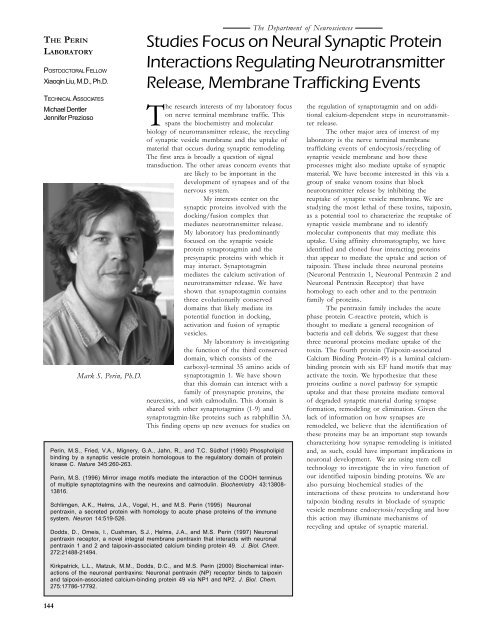Scientific Report 2003-2004 - Cleveland Clinic Lerner Research ...
Scientific Report 2003-2004 - Cleveland Clinic Lerner Research ...
Scientific Report 2003-2004 - Cleveland Clinic Lerner Research ...
- No tags were found...
Create successful ePaper yourself
Turn your PDF publications into a flip-book with our unique Google optimized e-Paper software.
THE PERINLABORATORYPOSTDOCTORAL FELLOWXiaoqin Liu, M.D., Ph.D.TECHNICAL ASSOCIATESStudies Focus on Neural Synaptic ProteinInteractions Regulating NeurotransmitterRelease, Membrane Trafficking EventsTheMichael Dentlerresearch interests of my laboratory focusJennifer Preziosoon nerve terminal membrane traffic. Thisspans the biochemistry and molecularbiology of neurotransmitter release, the recyclingof synaptic vesicle membrane and the uptake ofmaterial that occurs during synaptic remodeling.The first area is broadly a question of signaltransduction. The other areas concern events thatare likely to be important in thedevelopment of synapses and of thenervous system.My interests center on thesynaptic proteins involved with thedocking/fusion complex thatmediates neurotransmitter release.My laboratory has predominantlyfocused on the synaptic vesicleprotein synaptotagmin and thepresynaptic proteins with which itmay interact. Synaptotagminmediates the calcium activation ofneurotransmitter release. We haveshown that synaptotagmin containsthree evolutionarily conserveddomains that likely mediate itspotential function in docking,activation and fusion of synapticvesicles.My laboratory is investigatingthe function of the third conserveddomain, which consists of thecarboxyl-terminal 35 amino acids ofMark S. Perin, Ph.D.synaptotagmin 1. We have shownthat this domain can interact with afamily of presynaptic proteins, theneurexins, and with calmodulin. This domain isshared with other synaptotagmins (1-9) andsynaptotagmin-like proteins such as rabphillin 3A.This finding opens up new avenues for studies onPerin, M.S., Fried, V.A., Mignery, G.A., Jahn, R., and T.C. Südhof (1990) Phospholipidbinding by a synaptic vesicle protein homologous to the regulatory domain of proteinkinase C. Nature 345:260-263.Perin, M.S. (1996) Mirror image motifs mediate the interaction of the COOH terminusof multiple synaptotagmins with the neurexins and calmodulin. Biochemistry 43:13808-13816.Schlimgen, A.K., Helms, J.A., Vogel, H., and M.S. Perin (1995) Neuronalpentraxin, a secreted protein with homology to acute phase proteins of the immunesystem. Neuron 14:519-526.Dodds, D., Omeis, I., Cushman, S.J., Helms, J.A., and M.S. Perin (1997) Neuronalpentraxin receptor, a novel integral membrane pentraxin that interacts with neuronalpentraxin 1 and 2 and taipoxin-associated calcium binding protein 49. J. Biol. Chem.272:21488-21494.Kirkpatrick, L.L., Matzuk, M.M., Dodds, D.C., and M.S. Perin (2000) Biochemical interactionsof the neuronal pentraxins: Neuronal pentraxin (NP) receptor binds to taipoxinand taipoxin-associated calcium-binding protein 49 via NP1 and NP2. J. Biol. Chem.275:17786-17792.The Department of Neurosciencesthe regulation of synaptotagmin and on additionalcalcium-dependent steps in neurotransmitterrelease.The other major area of interest of mylaboratory is the nerve terminal membranetrafficking events of endocytosis/recycling ofsynaptic vesicle membrane and how theseprocesses might also mediate uptake of synapticmaterial. We have become interested in this via agroup of snake venom toxins that blockneurotransmitter release by inhibiting thereuptake of synaptic vesicle membrane. We arestudying the most lethal of these toxins, taipoxin,as a potential tool to characterize the reuptake ofsynaptic vesicle membrane and to identifymolecular components that may mediate thisuptake. Using affinity chromatography, we haveidentified and cloned four interacting proteinsthat appear to mediate the uptake and action oftaipoxin. These include three neuronal proteins(Neuronal Pentraxin 1, Neuronal Pentraxin 2 andNeuronal Pentraxin Receptor) that havehomology to each other and to the pentraxinfamily of proteins.The pentraxin family includes the acutephase protein C-reactive protein, which isthought to mediate a general recognition ofbacteria and cell debris. We suggest that thesethree neuronal proteins mediate uptake of thetoxin. The fourth protein (Taipoxin-associatedCalcium Binding Protein-49) is a luminal calciumbindingprotein with six EF hand motifs that mayactivate the toxin. We hypothesize that theseproteins outline a novel pathway for synapticuptake and that these proteins mediate removalof degraded synaptic material during synapseformation, remodeling or elimination. Given thelack of information on how synapses areremodeled, we believe that the identification ofthese proteins may be an important step towardscharacterizing how synapse remodeling is initiatedand, as such, could have important implications inneuronal development. We are using stem celltechnology to investigate the in vivo function ofour identified taipoxin binding proteins. We arealso pursuing biochemical studies of theinteractions of these proteins to understand howtaipoxin binding results in blockade of synapticvesicle membrane endocytosis/recycling and howthis action may illuminate mechanisms ofrecycling and uptake of synaptic material.144
















